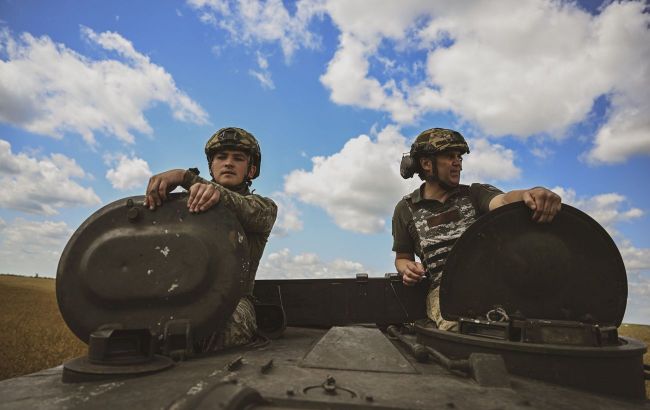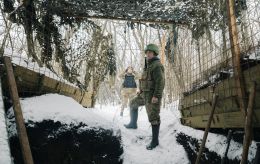Defense breached: How the Ukrainian Armed Forces landed in Crimea and entered Robotyne
 Ukrainian military forces have breached the Russian defense in the south (photo Getty Images)
Ukrainian military forces have breached the Russian defense in the south (photo Getty Images)
Last week was eventful: Ukrainian forces achieved a breakthrough in the south and, for the first time, landed in occupied Crimea. Read more about the main events on the front in the material by RBC-Ukraine.
Bakhmut. Battles on intercept courses
The battles here are intense, despite there being hardly any changes on the maps. The main focus is on the southern flank, where the enemy is being pushed out of Klishchiivka, Andriivka, and Kurdyumivka. They are putting up fierce resistance because if the Defense Forces succeed, they will reach the southern outskirts of Bakhmut.
For the first time in several weeks, there have been reports of progress on the northern flank. According to analysts from the Institute for the Study of War (ISW), on August 24th, troops advanced in the area near Zaliznyanske at Orihovo-Vasylivka.
They also noted Russian claims of Ukrainian Armed Forces advancing near Klishchiivka and capturing advanced positions to the west of the settlement. Later, the General Staff spokesperson Andrii Kovalenko confirmed the consolidation of new positions.
Deputy Minister of Defense Hanna Maliar says that the heights around Bakhmut suggest a semi-encirclement. Despite constant enemy attacks, our forces have pushed them back in the central part of Klishchiivka and to the east of this village, and have also prevented them from retaking positions on the northern outskirts of Bakhmut.
"In the Orikhovo-Vasylivka area... There, the enemy is putting up strong resistance. But we are making progress there," she added.

The Ukrainian Armed Forces are advancing on Bakhmut from both the south and north flanks (photo: deepstatemap.live)
In total, one more square kilometer of territory was liberated in the Bakhmut direction during the week. Since the counteroffensive began, it's now 44 square kilometers in total. The enemy is suffering significant losses in equipment and is clinging to every trench, showering Ukrainian soldiers with massive artillery fire.
"In the Klishchiivka area, battles are literally fought for every house. The situation there is difficult, and there isn't really much progress, especially since many Russians have concentrated arms and personnel there. Near Andriivka, the situation is more dynamic and favorable for us, but again, moving forward is tough. Here, the Ukrainian army is acting on character, forcing the superior enemy forces to retreat," military expert Vladyslav Seleznov revealed.
He also calls the Ukrainian advance being stopped at all costs a demonstration of how political goals triumph over military rationality.
"Putin demands victories and doesn't want Russian society to know about losses. That's why, despite the critical situation in some areas, they persistently hold the defense. Russians just can't announce bad news to their people before September 10, the single voting day," Seleznov believes.
Kupiansk and Lyman. Russia is deploying forces
Defensive forces continue to hold back the Russians in the Kupiansk and Lyman directions. According to the General Staff's reports, the enemy is probing for weak points and preparing for a regrouping. Near Lyman, there were attempts by the enemy to advance near Novoyehorivka, Kreminna, and Bilohorivka in the Luhansk region, as well as Vesele in the Donetsk region.
The regrouping is driven by significant losses. The Commander of the Army of the Armed Forces of Ukraine, Oleksandr Syrskii, responsible for the eastern sector, notes that Russia is transferring new brigades and divisions from its territory, apparently to strike with renewed strength.
"In such conditions, we must promptly take all measures to strengthen our defense in the threatened directions and advance where possible," the general emphasized.
British intelligence warns that in the next two months, Russia intends to intensify its offensive in Lyman and Kupiansk, seize the initiative, break through to the eastern bank of the Oskil River, and create a buffer zone around the Luhansk region.

The Russians have achieved limited success near Kupiansk and have stabilized the line to the northeast of the city (photo: deepstatemap.live)
Today, the estimated number of occupiers here is approximately 100,000: about 45,000 in the Kupiansk direction and 48,000 in the Lyman direction. So-called Storm-Z units and regular forces, including tank units, are being thrown into the assaults.
"Their plans remain the same. Simply overwhelming our positions with their numbers and creating so-called 'fire barriers,' as described in Soviet textbooks. For example, to capture a company or platoon-sized strongpoint, they need to use 40,000 rounds of ammunition. They indeed use these 40,000 rounds, but their accuracy and precision could be better," explained the Press officer of the Land Forces of Armed Forces of Ukraine Ilia Yevlash.
Judging by the maps, the enemy is still approaching Kupiansk, stabilizing the line between the villages of Lyman Pershyi and Pershotravneve to the northeast of the city. Defense Minister Oleksii Reznikov confirmed some Russian successes but assured that once our forces advance Bahmut, the enemy risks being encircled.
Vladyslav Seleznov links the occupiers' activity to the September elections.
"It is obvious that the dynamics of the combat actions will remain the same; the enemy will make every effort to increase its forces and means. Will they be able to turn their quantitative superiority into territorial gains near Kupiansk? I doubt it. Considering that they withdrew the 76th Guards Air Assault Division from there, one of the most combat-ready divisions, it seems that the 'great offensive of General Gerasimov' (the Chief of the General Staff of the Russian Armed Forces - Ed.) is slowly curling up and heading to a well-known place," the expert emphasized.
It should be noted that it was previously reported that the Pskov Airborne Division was redeployed to Robotyne in the Zaporizhzhia region, where the Ukrainian Armed Forces breached the first line of defense.
Southern Front. Robotyne is under control, the first line is breached
It was clear last week that the occupiers' defense in the Robotyne area had been breached. Two days ago, Hanna Maliar officially confirmed the liberation of this village.
This small settlement in the Zaporizhzhia region, south of Orikhiv, had special tactical significance. Military experts referred to it as a key fortified area on the way to Tokmak, which the Russians turned into a powerful logistics base.
Tokmak, in turn, opens up further possibilities for advancing toward Melitopol. Thus, it is a step toward cutting off the land corridor to Crimea, which the aggressor is desperately trying to maintain.
From a military-strategic point of view, the liberation of Robotyne itself doesn't offer much to the advancing forces. According to expert Oleksii Hetman, what matters much more is the territory and what is located on it.
"Of course, it's important that we've liberated Robotyne. But we're not fighting for individual villages; we're trying to break through a strong defense. So, the focus should not be on Robotyne itself but on the fact that we've breached the first line, come very close to the second, and in some places, we'll soon start breaking through it," he said in an interview.

Following Robotyne, the Ukrainian Armed Forces are advancing toward Novoprokopivka and Ocheretuvate (photo: google.com/maps)
Currently, Ukrainian forces are moving in two lines: Novodanylivka - Novoprokopiivka and Mala Tokmachka - Ocheretuvate, widening the wedge between Robotyne and the village of Verbove. Control over these "destinations" will allow them to block two of the three main roads to Tokmak, leaving only a few kilometers to the city itself.
You can read more about it in the article "Powerful breakthrough: How significant is Robotyne liberation and should we expect Ukrainian advance toward Tokmak"
Hetman describes the occupied Tokmak as an intermediate goal and is not ready to make predictions about the timing. However, he is confident that the enemy will fiercely defend the city. Beyond Tokmak, there are virtually no fortifications until Melitopol and the Sea of Azov, only checkpoints. And if the second - i.e., the main in this case - line of defense is breached, the Russians will have to hope they can hold out until mid-autumn. That is unless the rains start, which could halt the advance of the Ukrainian Armed Forces.
Natalia Humeniuk, the Head of the United Coordinating Press Center of Security and Defense Forces of the South of Ukraine, says that the liberation of any village exerts strong psychological pressure on the enemy.
"In conditions of hybrid warfare, this is also a weapon," she noted.
As for whether the Russians can retake positions near Robotyne, such an option is not even considered, according to her. Humeniuk says that the troops are advancing beyond the breached defense, and the enemy is retreating without a chance to consolidate.
You can read more about how the Russian defense is arranged in the south in the article by RBC-Ukraine
The pace of our troops' advancement in the West has led to speculation about whether Ukraine should concentrate its forces in the south. At least, as reported by The New York Times, citing unnamed American officials, the U.S. is allegedly dissatisfied with the fact that the Ukrainian Armed Forces are too dispersed. And that there are more military forces in the east than advancing in the Zaporizhzhia region.
In response, President Volodymyr Zelenskyy reminded that there are about 200,000 occupiers in the east, and if they weaken that direction, they risk losing Sloviansk, Kramatorsk, Kharkiv, and perhaps most of the territories up to the Dnipro River.
Crimea is within the reach of ground operations
After a year and a half of Russian invasion, military intelligence and the Ukrainian Navy decided to boost Ukrainian morale and landed in Crimea on Independence Day.
On the morning of August 24, local Telegram channels reported explosions and clashes in the western part of the peninsula at Cape Tarkhankut. It turned out that in the area of the villages of Olenivka and Mayak, Ukrainian troops engaged in battle with occupiers, inflicted losses, destroyed equipment, raised the blue and yellow flag, and safely returned to base.
Representatives of the Defense Intelligence assured that there were no losses on the Ukrainian side, and all assigned tasks were completed. At least 30 Russian military personnel were eliminated, and four fast patrol boats were damaged. The raid on Tarkhankut demonstrated that the entire Crimea is within the reach of ground special operations.
It's worth noting that the landing site was not chosen randomly. The area around Olenivka and Mayak is home to a radar node of the 3rd Radio Technical Regiment of the Russian Aerospace Forces, surrounded by air defense systems.
Vladyslav Seleznov considers the Crimea landing as part of a carefully planned operation to weaken the combat potential of the Russian army. A day before this, Ukrainian forces struck an entire S-400 division (air defense systems), a military unit, and possibly the Bastion coastal complex and the Podlet (Approach) radar station.
"That S-400 was causing serious problems for our UAV operators and kamikaze drones; the enemy was shooting them down too frequently. Thanks to high-tech missile weaponry based on the Neptun missile, we managed to destroy the station itself, loaded missiles, and part of the operators and support staff," Seleznov says.
The air defense system had a hole in it, and after the raid, 40 kamikaze drones attacked Crimea. Despite the statements of the so-called governors that everything had been shot down, explosions did occur, including near the location of the 126th Separate Guards Horlivka Brigade of the Coast Guard in the town of Perevalne near Simferopol.
"Will there be more operations like this? Of course, there will be. Volodymyr Zelenskyy once asked the people of Crimea to stay away from military facilities because it's deadly dangerous. He's right, so 'bavovna' (explosions, ironically - Ed.) there, I think, will sound even more frequently," the expert adds.
The events in Crimea also served another purpose. As the Defense Intelligence Chief, Kyrylo Budanov, stated, the Crimeans themselves must believe in Ukraine. He warned that pinpoint strikes would not be the limit, and a large-scale ground operation on the Ukrainian peninsula is quite likely to happen.
***
The Ukrainian offensive has been ongoing for nearly three months. Recently, Defense Minister Oleksii Reznikov responded to Western media reports calling it too slow. According to him, everything is proceeding according to plan, and Ukraine will not risk soldiers and equipment to speed up.
As explained by the Center for Strategic Communications, the current counteroffensive is the toughest of those conducted so far. But overall, the situation in the Zaporizhzhia and the southern Donetsk regions can be compared to what happened on the right bank of the Kherson region in 2022 when Russian positions were long breached, and then they moved forward quickly.
The Center also notes that the main processes cannot be seen on a map. The most important thing now is to destroy logistics, places of concentration of enemy forces, and equipment. This tactic brought victory the last time.

